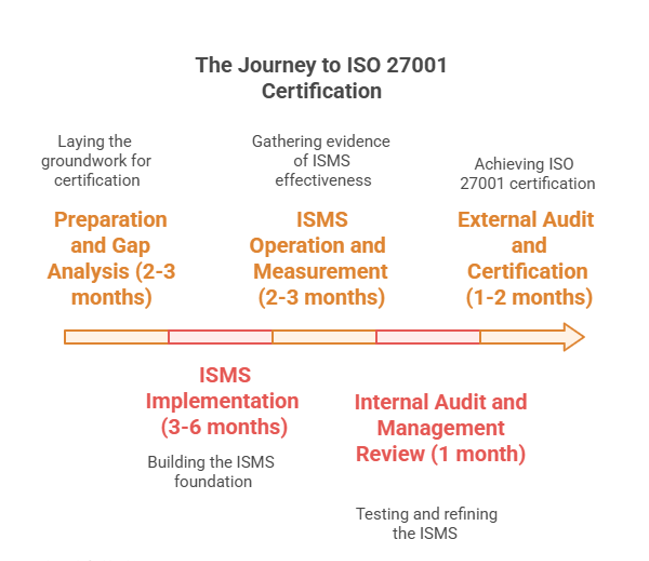Found this helpful? Share it with peers.
Introduction
Information security is the foundation for operating securely in the digital landscape. As an internationally recognized standard, ISO 27001 has set the benchmark for an Information Security Management System (ISMS). For good reason – cyber attacks increased by 38 % worldwide in 2024. ISO 27001 certification is now a must-have for cyber resilience and sends a clear signal of trust to every stakeholder.
Are you about to seek your first certification? Or renewing an existing one? No matter where you stand, this guide will equip you with practical tips to navigate the process with ease.
What is ISO 27001 Certification?
ISO 27001 certification is the official stamp that an organization’s ISMS meets the rigorous requirements of ISO/IEC 27001 – the global framework for managing and safeguarding information assets. It proves you follow a structured, risk‑based approach to security.
Key Requirements for ISO 27001 certification
To achieve ISO 27001 certification, an organization must demonstrate the following:
-
A clear, documented approach to managing security risks
-
Implementation of the 114 controls from Annex A, spanning 14 domains
-
Evidence of adherence to global best practices for protecting sensitive data
-
Strong leadership commitment and a continual improvement mindset

Alan Calder,
Founder of IT Governance
Certification Authority and Validity
ISO doesn’t certify organizations itself – accredited bodies like BSI, Bureau Veritas or SGS handle the audits. Once you pass, your certificate lasts three years, with annual surveillance audits to keep your ISMS sharp and compliant.
Keeping your ISMS effective requires regular internal checks and updates. ADOGRC streamlines continuous compliance with built-in risk management and monitoring tools. Its real-time dashboards, automated reports and proactive alerts ensure you always know how your ISMS is performing and can quickly adapt to new standards or threats.
Hint: Discover ADOGRC’s integrated ISO 27001 solution for seamless compliance.
The Complete ISO 27001 Certification Process: Timeline and Requirements
The journey to certification unfolds over several phases, each with clear objectives and milestones.
Phase 1: Preparation and Gap Analysis (2-3 months)
Kick off by mapping your organization’s current security posture against ISO 27001. Make sure to secure executive support, set up governance, define your ISMS scope, and perform a Gap Analysis. This uncovers missing controls, outdated policies or documentation lapses. A roadmap with roles, timelines and risk-assessment plans keeps the team aligned. Keeping the initial scope focused helps you build momentum before scaling up.
How ADOGRC helps: Use its compliance library to instantly map existing practices to ISO 27001 controls and automate your Gap-Analysis reports.
Phase 2: ISMS Implementation (3-6 months)
In the second phase you roll out your ISMS foundation: document the Statement of Applicability (SoA), draft policies and procedures, and establish your risk methodology. Risk management will consist of identifying assets, assessing risks, defining treatment plans and selecting controls. These controls will address technical elements such as access management and encryption, physical security measures, and administrative processes, including policies and staff training.
How ADOGRC helps: Automate policy generation, track control implementation and schedule recurring assessments to prove continuous compliance.
Below is a breakdown of the typical controls, their priorities, and the estimated implementation timelines:
| Control Domain |
Implementation Priority
|
Typical Implementation Time |
|---|---|---|
| Information Security Policies | High | 1-2 weeks |
| Organization of Information Security | High | 2-3 weeks |
| Access Control | Critical | 4-6 weeks |
| Cryptography | Medium-High | 2-4 weeks |
| Physical Security | Medium | 3-4 weeks |
| Operational Security | High | 4-8 weeks |
Phase 3: ISMS Operation and Measurement (2-3 months)
Once controls are live, it is essential to monitor and measure performance. Roll out security-awareness training, log incidents, track KPIs and conduct management reviews. Gathering concrete evidence that controls work as intended is key to passing audits.
How ADOGRC helps: Real-time dashboards and automated reports make performance tracking effortless.
Phase 4: Internal Audit and Management Review (1 month)
Before the external audit, run an internal check of the effectiveness of documentation and controls. Any issues identified should be addressed before the formal review. Following the internal audit, you should conduct a management review to evaluate the results of the audit, update risk assessments, review security metrics and ensure that the necessary improvements are planned.
How ADOGRC helps: Use its Audit Management module – complete with checklists, task assignments and audit trails – to centralize the entire process.
Phase 5: External Audit and Certification (1-2 months)
Your external audit consists of two stages:
Stage 1 – Documentation review: Auditors examine your ISMS scope, risk methodology, policies, procedures, and SoA, highlighting any areas for adjustment before Stage 2.
Stage 2 – On-site validation: Includes a deeper view into operational aspects. Interviews, evidence sampling and process checks confirm your ISMS operates as claimed.
Successfully passing both stages will result in the issuance of ISO 27001 certification, valid for three years, subject to annual surveillance audits.

Timetable for obtaining ISO 27001 certification
Common Challenges and How to Overcome Them
Although the process is well-defined, challenges often arise. Below are some common obstacles and strategies to overcome them:
Lack of Management Support: Without executive buy-in, resources and priority may be lacking.
Solution: Combat this by presenting a quantified business case – data breaches cost an average of $4.45 million in 2023 – and demonstrating how live risk dashboards make security measurable.
Scope Creep: Expanding the scope midway through the process can disrupt timelines and budgets.
Solution: Prevent unexpected expansions by formalizing scope boundaries and controlling changes through a documented process. ADOGRC maintains a central overview of all compliance objectives to keep scope in check.
Resource Constraints: Limited staff can delay progress.
Solution: Phase deliverables, supplement with external expertise and automate repetitive tasks to maximize efficiency.
Documentation Overload: The volume of required documentation can be overwhelming.
Solution: Use template libraries and auto-fill capabilities to reduce manual effort.
Framework Integration: Aligning ISO 27001 with other frameworks like SOC 2 or NIST can be challenging.
Solution: Map controls once to cover multiple standards – ISO 27001, SOC 2, NIST CSF or GDPR – rather than duplicating work.
The Measurable Benefits of ISO 27001 Certification
Beyond reputational gains, certification yields concrete returns:
- 62 % fewer security incidents
- 40 % faster incident response
- 34 % lower audit costs, thanks to 89 % overlap with GDPR and 93 % with HIPAA
- 14.1 % higher win rates; 76 % of large clients prefer certified partners
- 147 % ROI over three years, with payback in 14–24 months
GRC platforms like ADOGRC amplify these benefits by automating risk assessments, compliance tracking and audit preparation.
ISO 27001 versus Other Security Frameworks
A comparison of ISO 27001 with other security frameworks highlights its global relevance and certification capability:
|
Framework
|
Primary Focus |
Geographic Relevance
|
Certification
|
Complementary with ISO 27001
|
|---|---|---|---|---|
| ISO 27001 | Information Security | Global | Yes | – |
| SOC 2 | Service Provider Security | North America | Yes | 78% overlap |
| NIST CSF | Cybersecurity | US (Global adoption) | No | 83% overlap |
| GDPR | Data Protection | EU/EEA | No | 89% overlap |
| HIPAA | Healthcare Data | US | No | 93% overlap |
Preparing for Annual Surveillance and Recertification
ISO 27001 certification requires ongoing effort. Surveillance audits in the first two years focus on specific components of the ISMS, including past corrections, internal audits, and management reviews. The third-year recertification is a comprehensive review, considering the overall effectiveness and adaptations to new security threats. It is advisable to treat this as an ongoing process, ensuring that a dedicated team continues to oversee the ISMS.
Summary
Although securing ISO 27001 certification requires dedication and resources, its impact is invaluable. It builds a resilient security framework that empowers your organisation to confront emerging threats confidently. Spanning roughly 6–12 months, the certification journey not only lowers risks but also strengthens your market reputation and underscores your commitment to industry best practices. As the cybersecurity landscape continues to evolve, maintaining an active and flexible ISMS remains a vital security and business strategy.
To simplify this process, leverage ADOGRC’s comprehensive toolset – complete with audit trackers, interactive risk assessments and customizable ISMS modules. These features can reduce your certification timeframe by up to 40 % and cut costs by 25–30 %. By consolidating all compliance activities into a single, integrated platform, ADOGRC helps you stay compliant, competitive and prepared for any legal or security challenge.





